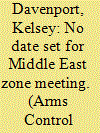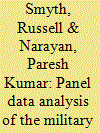|
|
|
Sort Order |
|
|
|
Items / Page
|
|
|
|
|
|
|
| Srl | Item |
| 1 |
ID:
176199


|
|
|
|
|
| Summary/Abstract |
China and the Middle East are both cradles of splendid civilizations. For over two thousand years, the network spun by the ancient Silk Road has connected Chinaand the countries in the Middle East at the east and west ends of Eurasia. The two sides enjoy a long history of close exchangesandfriendship, with no historical grievances in the past or conflicts at present. This truly exemplifies what is meant by the saying “Good friends feel close to each other even when they are separated by vast distance.”On 30 May 1956, the People’s Republic of China and the Republic of Egypt officially established diplomatic relations. That was the beginning of diplomatic engagement between New China and Middle Eastern countries. Over the past 60-plus years, the relations between the two sides have been through several stages defined by deepening mutualunderstanding, setbacks and adjustments, build-up of momentum, and majorbreakthroughs. The two sides have helped each other in an evolving world and carried out sincere cooperation for their respective national development. In this process, they have become like-minded friends, mutually beneficial partners, and good brothers who stick together through thick and thin.
|
|
|
|
|
|
|
|
|
|
|
|
|
|
|
|
| 2 |
ID:
120854


|
|
|
|
|
| Publication |
2013.
|
| Summary/Abstract |
In 1949, the United Nations sent its first mission to the Middle East in order to provide help to Palestinian refugees. This was the first step towards a development policy from this international institution. Analyses of the Iraqi (1952) and the Syrian (1955) missions can help an understanding of how Middle Eastern countries were involved in the work of the new international organization. Indeed, these investigations testify to a new policy to improve economic and social conditions in the Middle East. This research points out interactions between national institutions, local personalities and international institution in order to give an idea about the methods of communication between the Middle East and the providers of United Nations assistance.
|
|
|
|
|
|
|
|
|
|
|
|
|
|
|
|
| 3 |
ID:
155843


|
|
|
|
|
| Summary/Abstract |
The economic growth effects of military expenditure have been the subject of a large literature in defence economics. Theories on the economic impacts of military expenditure greatly differ and include arguments that they either enhance economic growth or crowd out productive investments. Empirical literature on defence expenditure and economic growth nexus generally employs linear specifications to investigate the impact of defence expenditures on economic growth. Although it is now well established that many economic variables may have a non-linear data-generating mechanism, it seems that this reality has long been neglected in empirical work on defence–growth nexus. This paper attempts to fill this gap by employing non-linear panel data models to examine the effects of military expenditures on economic growth for Middle Eastern countries and Turkey, for the time period 1988–2012. Results show that the effect of military expenditure on economic growth is nonlinear such that the state of the economy actually determines the effect of the former on the latter. This is important not only in showing asymmetric relationship between these variables but also in revealing the reasons of mixed results of earlier literature.
|
|
|
|
|
|
|
|
|
|
|
|
|
|
|
|
| 4 |
ID:
128065


|
|
|
|
|
| Publication |
2013.
|
| Summary/Abstract |
Middle Eastern countries gathered last month to discuss the agenda for a conference on creating a zone free of weapons of mass destruction (WMD) in the Middle East, but made no announcement that they had made progress toward setting a date to convene the conference. The countries continue to disagree over the agenda, an official familiar with the process told Arms Control Today in an Oct. 29 e-mail. Iran, Israel, and all the Arab League countries attended the meeting, which was held Oct. 21-22 in Glion, Switzerland. Progress on the agenda has been held up over disagreements as to what weapons the zone's ban should cover because some countries favor expanding the ban to include limits on certain types of conventional weapons, the official said. The countries might meet again this month, the official added, but it is unclear if all will attend given the "frustration" over the lack of progress.
|
|
|
|
|
|
|
|
|
|
|
|
|
|
|
|
| 5 |
ID:
087571


|
|
|
|
|
| Publication |
2009.
|
| Summary/Abstract |
While a number of studies examine the nexus between military expenditure and economic growth, little consideration has been give to the effect of military expenditure on external debt. This article examines the impact of military expenditure and income on external debt for a panel of six Middle Eastern countries - Oman, Syria, Yemen, Bahrain, Iran, and Jordan - over the period 1988 to 2002. The Middle East represents an interesting study of the effect of military expenditure on external debt because it has one of the highest rates of arms imports in the world and it is one of the most indebted regions in the world. The study first establishes whether there is a long-run relationship between military expenditure, income, and external debt in the six countries using a panel unit root and panel cointegration framework and then proceeds to estimate the long-run and short-run effects of military expenditure and income on external debt. The study finds that external debt is elastic with respect to military expenditure in the long run and inelastic with respect to military expenditure in the short run. For the panel of six Middle Eastern countries, in the long run a 1% increase in military expenditure results in between a 1.1 % and 1.6% increase in external debt, while a 1% increase in income reduces external debt by between 0.6% and 0.8%, depending on the specific estimator employed. In the short run, a 1% increase in military expenditure increases external debt by 0.2%, while the effect of income on external debt is statistically insignificant.
|
|
|
|
|
|
|
|
|
|
|
|
|
|
|
|
|
|
|
|
|